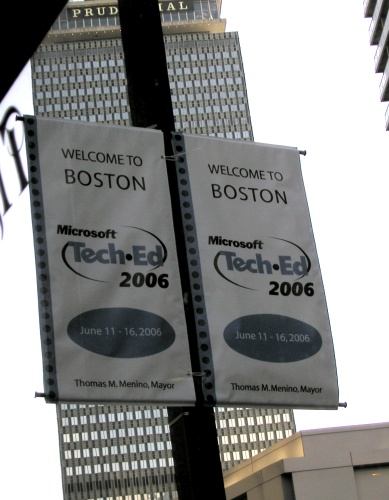So here I sit in my hotel having just attended the keynote. Before I get to talking about the keynote, I noticed these signs all over the place on the way over:

You know that you’re at a big conference when the city puts up big signs all over the downtown welcoming you. Uh, thanks, Boston. Glad to be here.
So let’s talk about the keynote… Bob Muglia started things off. This year’s theme was “People-Ready Software”. Bob reiterated Steve Ballmer’s sentiments that the products (Vista, Longhorn Server, Exchange 2007, Office 2007, etc.) will ship when they are ready. They are on-target for the planned dates, but that could change based on feedback on the betas from a wider audience. (Steve Ballmer got everyone’s knickers in a knot when he made this comment a few weeks ago. Some analysts and journalists took this to mean that Vista is going to slip again rather than the real sentiment that they won’t knowingly ship a shoddy product.) With that, Bob introduced Ray Ozzie. (Rumour has it that Ray is being groomed to take over from Bill.) Overall I enjoyed hearing Ray Ozzie speak – definitely the best speaker of the keynote. People describe him as a visionary, which I think is accurate, though I was hoping for him to be more visionary. Much of what he said was common sense. Even if you don’t agree with everything he says, you can see that he has an idea of the future and how to get there. His track record speaks volumes as he was involved in Visi-calc, Lotus 1-2-3, Lotus Notes, and Groove. (Microsoft bought Ray Ozzie and got a nice product called Groove thrown in for free.) To further fuel the rumour that Ray is taking over for Bill is that Bill was neither seen nor mentioned.
So what did Ray talk about? He forsees a new era of disruption, much like the disruption caused by the PC, the LAN, the internet, and P2P networks. He dismissed other companies’ (read Google) notions that the next big event will be completely web-based AJAX-enabled applications. Yes, you can do amazing things on the web and Microsoft will help developers build those next generation web applications, but more important is applications with architectural flexibility, for which he used Groove as an example. (Big surpirse.) The next generation of software will be enabled to connect peer-to-peer or client-server, depending on whether you’re inside or outside your corporate firewall. Applications will be centrally managed whether they’re connecting P2P or client-server. So if you have a number of employees away from head-office, they can create an ad-hoc network for sharing ideas and information and then sync up once they are back. He also talked about the work that Microsoft is doing with respect to federating corporate Active Directory with Windows Live Identity. This will allow your corporate identity to be used in trust relationships with partners. The basic idea of federation is one corporate identity that can be used with trading partners. So if someone from ABC Inc. buys widgets from XYZ Corporation and she needs to log into the XYZ order fulfilment site, federation would allow XYZ Corporation to assign access permissions based on her ABC login rather than having to issue her a XYZ user account. Very cool stuff. He talked about managing personal devices via group policy. People bring personal cell phones, laptops, and memory sticks to work because they find them useful. Rather than forbidding all personal devices, the plan is to establish acceptable use policies using group policy. Lastly he talked about “The Services Disruption” – Enterprise Services and Internet Services melding together. Blended internet/intranet search. The idea of “Client, Server, and Service”. Dynamic and charismatic speaker. I can see why everyone thinks he’ll take over from Bill. So that was The Good.
Bob comes back and introduces the idea of the “4 Promises” that Microsoft is making to its customers and partners. He introduces Mary Lynn Rajskub, who plays Chloe on the show “24” opposite Kiefer Sutherland. (I’ve never actually watched “24”. So no comments on the show.) This is a lead-up to the first of a 4-part series called “4”, which parodies “24”, and stars much of the Microsoft brass (minus Bill again) as the server room interns. We see the 4 parts in installments throughout the 2-1/2 hour keynote. Some are vaguely amusing, but overall rather silly. The outtakes at the end are the best part showing the Microsoft brass goofing around. Chloe also visits us repeatedly throughout the keynote delivering lame lines read verbatim from a ticker. Her performance was painful. I could almost hear her thinking “what has my agent gotten me into”. That was The Bad. So rather than dwell on that any more, let’s look at the 4 promises:
- Manage Complexity, Achieve Agility
- Protect Information, Control Access
- Advance the Business with IT Solutions
- Amplify the Impact of Your People
I won’t recount each of the promises, but here are some outtakes from each one.
Promise #1: Manage Complexity, Achieve Agility
- 3 different types of virtualization, each with its own benefits and drawbacks
- Hardware virtualization – Where we are today
- OS Services virtualization – furthest out – past Longhorn – very important in hosting situations
- Application virtualization – Microsoft acquired Softricity to enable this scenario – incompatible applications running side-by-side in the same OS – for instance different versions of Office
- Demo of Windows Server Virtualization, which will ship with Longhorn Server
- Can allocate more than 3.6 GB of memory to a guest OS with >32 GB possible
- Guest OSs can be assigned up to up to 8 CPUs – currently Virtual Server supports 1 or 2
- You can dynamically change the amount of memory allocated to a guest OS without re-starting the guest! Very cool!
- Hot adding of disk space, CPUs, and NICs is also possible.
- 64-bit guest OS support!
Promise #2 – Protect Information, Control Access
- Microsoft Forefront Client Security announced
- Antigen (for Exchange, SharePoint, etc.) can use up to 9 AV engines for enhanced protection
Promise #3 – Advance the Business with IT Solutions
- Demo of Visual Studio Team System for DB Pros
- Refactoring support in the database
- Unit testing in the database written in T-SQL
- Demo of Expression Interactive Designer for use by graphic artists
- File format is XAML
- Programmer can use the same file in Visual Studio and implement code-behind much like ASP.NET, but for a graphically rich application
Promise #4 -Amplify the Impact of Your People
- Product launches announced
- Office Enterprise 2007 – October 2006
- SPS 2007 – October 2006 – intranet, internet, extranet, enterprise search
- Exchange 2007 – Beta 2 in July – email, calendar, & unified messaging server
- Live Communications Server “12” – Available in 2007 – real-time communication – IM and video calls
- Office SharePoint Server will allow you to create wikis and blogs
Summary
It was an interesting keynote, but no huge revelations. Much of what was announced had been discussed previously. We did get to see some cool demos. You may be wondering what the ugly was from my list. In my notes I have written, “Chloe is back to wrap up show – please kill me”. Still it promises to be a fun TechEd.






